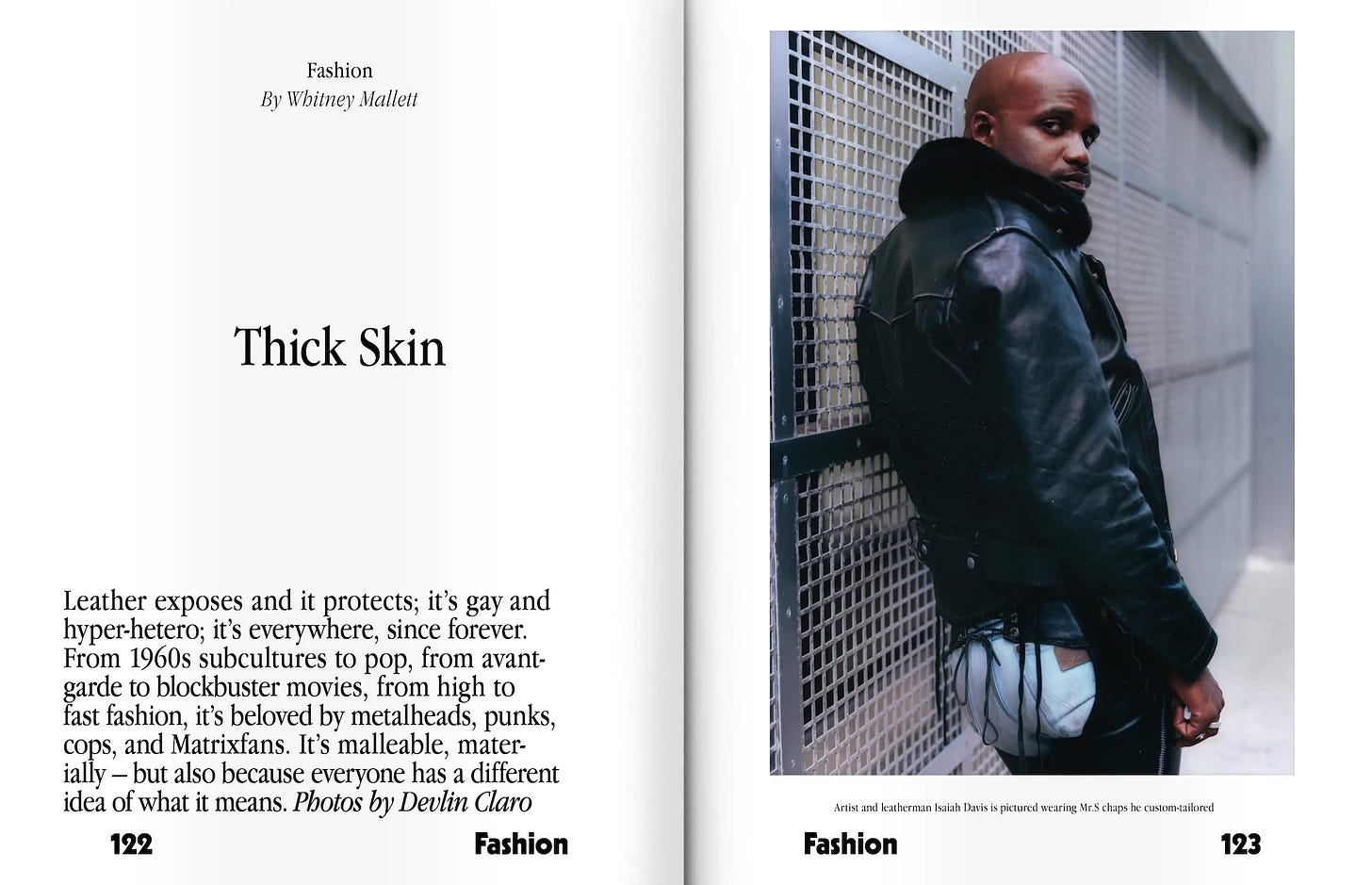An essay on learning about leather through my boo, Isaiah Davis, photographed by Devlin Claro, for Spike Magazine’s vulnerability issue.
When my partner, Isaiah Davis, gets a new leather piece — and acquisitions are fairly frequent, he’s an artist and leatherman with an archival practice that borders on compulsive — he does something he calls a “stress test.” This is a trial to see how much extra attention bearing the item in the wild brings him, a real-world understanding of how moving through the streets of New York in a specific jacket or pair of chaps is going to provoke certain gawks or glances, sometimes passive aggressive jabs, or unwanted sexual advances. Leather is a contradiction. It’s a uniform to hide in, and made from literal hides, armor designed to shelter our soft bodies speeding on motorcycles and in early airplanes. There’s an emotional security in its physical durability, as well as an anonymity to slipping behind the mask of the macho archetypes it signals. And while it protects, it exposes at the same time. There’s a vulnerability to being looked at but not necessarily being seen. Everyone has a different idea of what leather means.
In Hal Fischer’s landmark 1970 photo series “Gay Semiotics,” he explains, “leather symbolizes non-conformity in both the straight and gay communities.” And while its countercultural connotations are countless – from greasers to punks, rockers to doms, dykes on bikes to beefcake clones – the signifier shifts and slips from law enforcement to outlaw, and back again. Take the classic motorcycle jacket first known as the LAPD (Los Angeles Police Department), now more commonly called the CHP (California Highway Patrol), a style made famous by Marlon Brando in 1953 when he played the brooding leader of a vicious biker gang in The Wild One. Over the years, the same leather shops that law enforcement agencies like the LAPD contracted to produce their uniforms were simultaneously selling jackets made with identical patterns to boutiques like New York’s The Leather Man, which has specialized in gear for the gay fetishist at its Christopher Street location since 1965, four years before the Stonewall Riots which took place a few blocks away. The cop look was a fantasy, one made gay canon by erotic artist Tom of Finland, whose signature bubbly bulging forms were first published in the 1950s when the criminalization of homosexuality was still violently enforced. By 1980, the feedback loop took on another dimension when Al Pacino played a cop undercover in the gay leather scene in Cruising (1980), his wardrobe spanning both a café racer and a quilted CHP, the character of an NYPD officer disguising himself to blend in amidst the heavy leather S&M underground by donning a jacket actively worn by motorcycle patrolmen on the West Coast.
With leather, like with anything, if you push too hard into one narrow interpretation, whether it’s of nonconformity or masculinity, whatever you’re holding too tightly is bound to collapse into its opposite. It’s there at the intersection of straight and gay, cop and criminal, but also when punk folds into fascism. (Remember when Sid Vicious wore a swastika T-shirt under leather, a look Lisa Rinna apologized for her husband recreating on Halloween not that many years ago.) It’s also a signifier dykes have appropriated to remake masculinity on their own terms. (Think leather lesbians and trans men like Kathy Acker, Barbara Hammer, and Pat Califia.) Leather is flexible, both in how the animal skin molds to your body over time, and its malleability on a symbolic level. Likewise, it is enduring – a quality jacket lasts a lifetime while, in spite of the recycled tropes and commercial commodifications, retaining an ability to signal defiance, even when its powers are diluted in lightweight fast fashion form. Lesbian style icon Justin Bieber was arrested during his bad boy phase for a DUI sporting baggy drop-crotch leather. Former Fox News anchor Gretchen Carlson went on the liberal networks to dish about her #MeToo callouts wearing mom-appropriate leather, as echoed by Nicole Kidman playing her in Bombshell (2019). Fashion magazines still publish articles like “Can I Pull Off Leather Pants?”
Keep reading with a 7-day free trial
Subscribe to Whitney Mallett to keep reading this post and get 7 days of free access to the full post archives.



